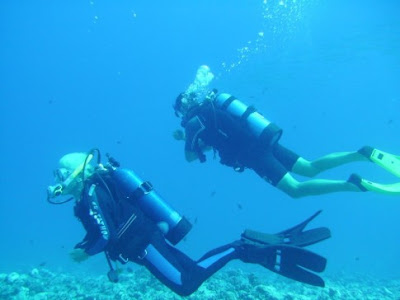June 26, 2010
Point Venus, Arue, Tahiti
S17 31.4 W149 32.1
We raised Tahiti out of the horizon at about 1 AM yesterday. Under a near full moon, the grand outline of the island came into focus as we sailed in light winds carrying all the sail that IO could manage. I spent my shift (midnight till morning) silently working the winds from three squalls to get us near shore. As the sun rose, we could make out Point Venus, the historical landing point of both Captians Cook and Bligh and the sight where the mutineers of the sailing ship Bounty returned to after they took control. We were guided into a local marina overlooking this place by our friends aboard Totem and Capaz.
While approaching Tahiti, at about 2 AM, I heard a French voice come on the VHF and give some coordinates that sounded close to us. A minute later the same voice, only speaking good English spoke again: "This is the French War-ship P802 calling the vessel off our port side at coordinates xxxxx, traveling on a course of 241 degrees at 4 knots, do you read me?" Crap, that's us! Seriously, does the navy of every country that we visit have to bother me? I mean really, we are the smallest boat on the bloody ocean, how much threat could we be? It turned out to be no big deal as usual, they just wanted to confirm our status and get our country of registration. It was most likely some bored radio operator with nothing better to do. But after I was hailed by the nuclear submarine in the strait of Juan de Fuca aboard my last boat (buy me a drink and I'll tell you that story some time), I find being hailed by the military of any country, simply annoying! And just for interest sake, since IO is a Canadian-registered vessel, we are bound by some archaic law that says IO is, in part, owed by the Queen of England and if any navy other than the Canadian navy tries to board her, it is considered an act of war! Cool, huh? If a foreign country wants to board us, they have to send their coast guard; it can't be the navy (as was done in the US several times and in the Marquesas).
As it turns out, we arrived here at the same time as Escapade, the other 30-foot sailboat that we met in La Cruz. We all went ashore to do the usual, find laundry, a grocery store and generally explore. While we were ashore, we saw a poster with a beautiful Tahitian woman on it saying that the 50th anniversary Miss Tahiti was being held tonight. The general consensus between Jim, Brendon, myself and surprisingly Hyo was that we definitely needed to experience some Tahitian culture. I will say that after being at sea for so long, all that drumming, dancing, hip shaking and exposed skin.WOW. And remember that I was with a beautiful woman the whole time at sea! (I think young Brendon was well and truly enthralled by that particular experience.) I admit that I may have been counted as one of the mutineers if that was what I was to return to!
Three days at sea is still a long passage, especially when the winds are light and the slatting of the main sail was enough to blow out three webbing sail slide attachments! More repairs, more sewing, but I cannot sew until I fix our "new" broken inverter. The Autopilot is busted, the sink fresh water pump is leaking and the list goes on and on. Like I have said before, the highs are so high and lows so low. Despite my whining about the little ongoing repairs, I am actually very grateful. There are two boats beside us that lost their masts somewhere between here and the Marquesas and we have heard many other stories of seriously broken boats including one that was abandoned during the major crossing. IO has been strong and not failed us in any way.
























